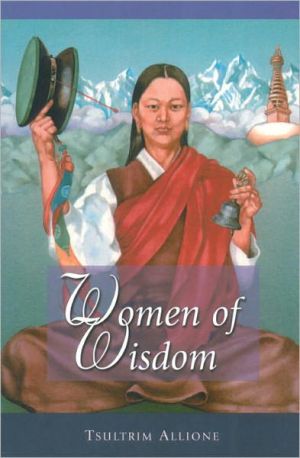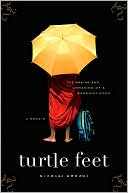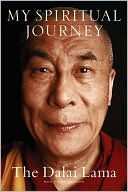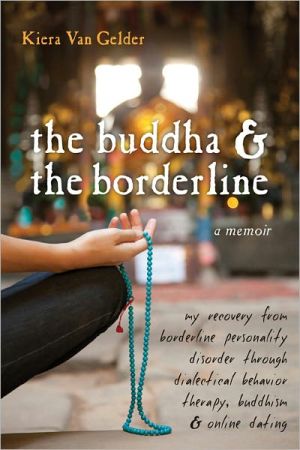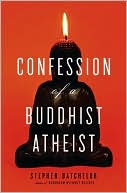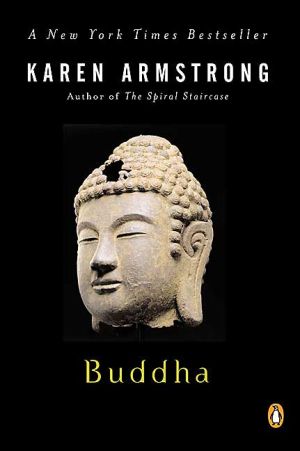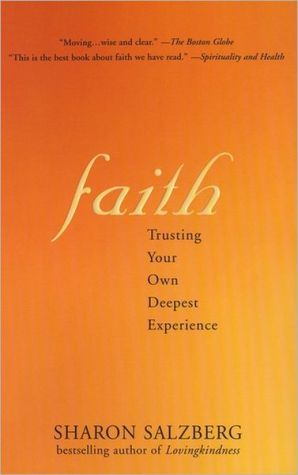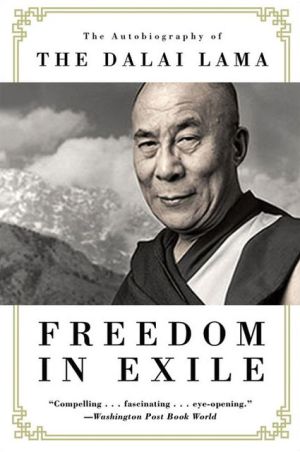Women of Wisdom
Women of Wisdom explores and celebrates the spiritual potential of all women, as exemplified by the lives of six Tibetan female mystics. These stories of great women who have achieved full illumination, overcoming cultural prejudices and a host of other problems which male practitioners do not encounter, offer a wealth of inspiration to everyone on the spiritual path.\ In this revised and expanded edition, Tsultrim Allione's extensive autobiographical preface and introduction speak directly...
Search in google:
Women of Wisdom is an exploration and celebration of the spiritual potential of all women, as exemplified by the lives of six Tibetan female mystics.
\ \ Chapter One\ \ \ A-Yu Khadro\ \ \ Prologue\ This first biography is the most contemporary in this collection. Itis interesting and special for several reasons apart from being a wonderfulstory. First, through Norbu Rinpoche's description of how thebiography came into being we can see the process of the making ofa namthar very vividly. We can see that what she selected was whatwould be relevant for another practitioner to know.\ This story also represents the lives of many great yoginis who livedand died in relative obscurity. The other biographies in this collectionare all of women who achieved great fame in their time. Wecan also see how the tradition Machig Lapdron handed downthrough generations from the eleventh century remains intact upinto modern times. Most of A-Yu Khadro's life before she went intoretreat consisted in living the life of a Chödpa, wandering from onepilgrimage place to another practicing the Chöd. We know that therewere others like her: for example, her lifelong friend Pema Yangkyi,with whom she traveled for years, achieved the rainbow body at thetime of her death. From this story we get the feeling of the freedomand independence of a Tibetan yogini.\ \ \ The Biography of\ A-Yu Khadro, Dorje Paldron\ \ \ Homage to Dorje Paldron and Vajra Yogini!\ This biography is only a drop of the nectar of A-Yu Khadro's life. AsI write of her I will try to remember her presence. I am the insignificantdisciple Namkhai Norbu, and this is the story of how I metA-Yu Khadro and how I came to write her lifestory.\ When I was fourteen in the Year of the Iron Rabbit, 1951, I wasstudying at Sakya College. My teacher there, Kenrab Odzer, had twicegiven me the complete teachings of Vajra Yogini in the Norpa andSharpa Sakya traditions.\ One day he said to me: "In the region of Tagzi, not far from yourfamily's home, lives an accomplished woman, a great dakini, A-YuKhadro. You should go to her and request the Vajra Yogini initiationfrom her."\ That year he let me leave a month early for the autumn holidayswith the understanding that I would be going to see A-Yu Khadro.So first I returned home and prepared to go with my mother YesheChodron and my sister Sonam Pundzom.\ We set off, and after a journey of three days, we arrived at A-YuKhadro's place in Dzongsa. She lived in a little stone hut near a riverin a meadow under the cliff face of a mountain to the east of a smallSakya monastery. The hut was tiny, with no windows. She had twoassistants, an old man, Palden, and an old nun, Zangmo. They werealso strong practitioners of yoga and meditation.\ We were very happy and amazed to see this situation. When weentered Khadro's room for the first time, only one butter lamp waslit. She was 113 at that time, but she did not look particularly ancient.She had very long hair that reached her knees. It was black atthe tips and white at the roots. Her hands looked like the hands ofa young woman. She wore a dark-red dress and a meditation beltover her left shoulder. During our visit we requested teachings, butshe kept saying that she was no one special and had no qualificationsto teach.\ When I asked her to give me the Vajra Yogini teachings she said:"I am just a simple old woman, how can I give teachings to you?"\ The more compliments we offered her, the more deferential shebecame toward us. I was discouraged and feared she might not giveus any teachings.\ That night we camped near the river, and the next morning, as wewere making breakfast, Ani Zangmo, the old nun, arrived with herniece bringing butter, cheese, and yogurt. These, she said, were forthe breakfast of my mother and sister, and I was to come to seeKhadro.\ I went immediately, and as I entered I noted that many more butterlamps were lit and she touched her forehead to mine, a great courtesy.She gave me a nice breakfast of yogurt and milk and told methat she had had an auspicious dream that night of her teacher,Jamyang Khentse Wangpo. He had advised her to give me the teachingsof Khadro Sangwa Kundu, his gongter. This was not the teachingI had asked for, but was a teaching she had received from himdirectly which she had practiced extensively. While we were havingbreakfast, she was examining the Tibetan calendar. Then she said:"Since tomorrow is the day of the dakini, we will begin then. Todaygo to visit the Sakya monastery, and in the meantime we will makepreparations."\ So we went off to visit the monastery and made some offeringsthere. They had statues of the Buddhas of the Three Times and astupa five arm-lengths high made of gilded bronze and studded withmany jewels. It had been made according to Khadro's instructions.Inside it was empty.\ The next day around eleven we began the initiation of KhadroSangdu. From that day on, every morning she gave teachings includingthe practices of the subtle nerves and the subtle breath. In theafternoon at the end of her meditation session, she gave furtherexplanation of the Khadro Sangdu and the Chöd of Machig Lapdron,the Zinba Rangdrol. This was the Chöd practice she had done formany years when she was younger. There were five of us receivingthese teachings: Khenpo Tragyal, the abbot of the monastery;Yangkyi, a nun; my mother; my sister; and I. Her hut was so smallthat not everyone could fit in, and Yangkyi had to sit outside thedoorway. The Khenpo assisted with the shrine and the mandalas.\ A month later, she began the Yang-Ti, one of the most importantof the Dzog Chen teachings in the most advanced Upadeshaseries, having to do with the practice in the dark. This teaching tookfive days. Then she began teaching on the Longchen Nying Thig.This ended on the twenty-fourth. In the seventh month on the tenthday, she gave the Vajra Yogini in the Sharpa tradition, the instructionI had requested, followed by a complete explanation. This waslinked to the Kha Khyab Rangdrol teachings of Nala PemaDundrub. Then she gave the complete teachings of her SinghamukhaGongter which took until the tenth of the following month. At theend she gave the long life White Tara practice. Not only did we receiveformal teaching, but in addition, she made time for informalconversations and personal advice. I was not with her a long time, alittle more than two months. During that time she had given eightkinds of teachings and was really so kind and gentle. We were verycontent with the generous gift of these precious teachings.\ The Khenpo, one of her principal disciples, told us that he had,from time to time, received teachings from her, but the kind andextent of the teachings she had given us were rare indeed. She normallydid not give much teaching and had never given so much insuch a short time. He was afraid this meant that she might pass awayvery soon. Then Palden, the old man, said that several months beforewe came she had had a dream indicating that she should givecertain teachings soon. Before we arrived they had begun the preparations.So there was definitely a motive for giving these teachings.\ Sometimes, at my request, after the afternoon teachings, she wouldtell me about her life. I had the peculiar habit of writing everythingdown, unusual for Tibetans, so I wrote down everything she toldme. From these notes I constructed this biography. What follows iswhat she herself told me.\ I would ask her a question, for example about her birth and childhood,and she replied: "I was born in the Fourteenth Rabjung in theYear of the Earth Boar, 1839, during the winter, on the day of thedakini. The Togden who lived on the nearby mountain, TogdenRangrig, was at our house when I was born. He named me DechenKhadro, which means "great bliss dakini."\ "Some people also reported some auspicious signs on the day ofmy birth. I was born in Tagzi in the village of Dzong Trang in thefamily of Ah-Tu Tahang. In ancient times this had been a very richfamily, but when I was born we were neither rich nor miserably poor.My father's name was Tamdrin Gon, but he was called Arta. Mymother's name was Tsokyi, but she was called Atso, and they hadthree sons and four daughters. All the sons became traders and allthe daughters did nomad's work, looking after animals. Since I wasthe youngest and the weakest, I was sent to look after the small animalsand given the worst clothes. This is the story of my birth andchildhood."\ Then I asked her how she had met a teacher and begun to practicemeditation. She said: "My aunt Dronkyi was a strong practitionerand lived near the cave of Togden Rangrig in another cave. Fromchildhood she had been interested in meditation, and I, too, wasstrongly drawn to the teachings. I went to this place, Drag ka YangDzong, by my own choice when I was seven. I stayed there until Iwas eighteen, in 1856. I assisted my aunt, bringing her water andfire wood. I also assisted a disciple of the Togden, Kunzang Longyang,and he taught me and his nephew Rinchen Namgyal to read andwrite Tibetan. I began to become quite good at reading because thedisciples of the Togden decided to read the Kangyur twice to extendthe Togden's life and I participated in this. When I was thirteen,I received initiation and teaching on the Longsal DorjeNyingpo. I also received the explanation and did my best to participatefully; although I had no understanding of the teaching really,I had much faith.\ "A man called Apho Tsenga came to receive this teaching. He wasfrom the rich family of Gara Tsong in the region of Nya Shi, whowere friends of my aunt. My parents also attended the teachings,but their minds were not on the teachings, but rather on my future.By the end of the teaching I had been betrothed against my will toApho Tsenga's son. I had no idea, really, what it meant, but I understoodan interruption to my practice was being planned. My auntdid her best to intervene, but my parents were interested in the wealthof the Gara Tsong family. They only consented to the wedding bedelayed a few years.\ "When I was fourteen, I went with my aunt and Togden Rangrigto see Jamyang Khentse Wongpo, Jamyang Kongtrul, and Cho GyurLingpa, three great lamas, gathered together to consecrate a certainplace. It was a seven-day journey to Dzong Tsho, and there we alsomet a lot of other teachers and great masters and received muchinstruction. My desire to participate more fully in the teachings increasedat this time, particularly when we stopped to see SituRinpoche at Pema Nyingkye on our way back. From him we receivedteaching on White Tara. After this we returned to the Togden's retreatplace, and he and my aunt went straight into retreat. I begandoing the preliminary practices of the Longchen Nying Thig in myspare time. I was instructed by Kunzang Longyang.\ "When I was sixteen, in the Year of the Wood Tiger, 1854, my auntand I went to see Jamyang Khentse Wongpo. When we arrived, weheard that he was in very strict retreat, but we sent him a messagesaying we had come from Togden Rangrig.\ "Since we had come from so far away with great self-sacrifice, heagreed to see us. When we met him, he told us that the precedingnight he had had a dream which indicated he should teach us. Hehad decided to initiate us into the Pema Nying Thig, his White TaraGongter. During the initiation he gave me the name TsewangPaldron. For more than a month, every time he finished a sessionhe gave us teachings. I began to get some idea of the meaning of theteachings at this time and when we returned to Togden's place, Ientered a White Tara retreat.\ "When I was nineteen, in the Year of the Fire Serpent, 1857, myparents and my brothers and sisters all decided it was high time Igot married. They began to make great preparations for my marriage,and my aunt was very worried. She felt responsible for introducingthe Gara Tsong family to my parents. It was against her advicethat they proceeded with my marriage. She pleaded that I should beleft to do what I wanted to do and that my practice should not beinterrupted. But my parents insisted on marriage—not for my happiness,rather for their gain.\ "The wedding took place towards the middle of the summer. Itwas a very happy occasion; even Togden Rangrig came to the weddingand showered blessings on us. It seemed as if we would behappy.\ "I stayed for three years with the Gara Tsong family, and my husband,Apho Wangdo, was very kind and generous. Then I fell ill andslowly weakened for two years. The sickness could not be diagnosed.Sometimes it seemed like a prana disease, at other times I had convulsionslike epilepsy; sometimes it seemed like a circulation problem.In short none of the doctors could help or even distinguishwhat the problem was. Whatever ritual or medicine was advised hadlittle effect. I became worse and worse and was near to death whenthey finally asked Togden Rangrig to come to see me.\ "He gave me a long-life initiation and performed a ceremony tocall the spirit back into the body and many other rituals. Both heand my aunt insisted that the real cause was that I was being forcedto lead a worldly life and stay in that household against my will.They told my husband and his family that I must be allowed to leaveand follow my heart. They told them about the signs at my birthand my encounters with Jamyang Khentse Wongpo. Finally, they convincedthem that marriage was a blockage of innate propensities tothe extent that it was endangering my life force.\ "My husband was a very kind man and agreed that if married lifewas endangering my life, it must be stopped. I told him that if hegenuinely understood and loved me, he would want to follow theTogden's advice and let me be free to go and do as I pleased. I alsotold him that I would welcome his assistance in my retreat and hopedwe could have a relationship of spiritual brothers and sisters, and ifhe agreed, perhaps I would get better.\ "He promised to do this, and who knows whether it was becauseof giving his word or the rituals of the Togden, but after a while Ibegan to get better. As soon as I was strong enough, he accompaniedme to the caves of the Togden and my aunt. It took me a yearto recuperate. I was helped very much because he made offerings toa nun there with the understanding that she would serve me andhelp me with the necessities. He and his sister also brought me foodand supplies, acting as my patrons. That year, I received the termasof Guru Chowang.\ "During this time I had a dream indicating that the passing awayof Togden Rangrig was imminent. When I told him this dream hesaid: `I have already given you all the teachings I received from mygurus Motrul Choying Dorje, Migyur Namkhai Dorje and RigdzinPema Dupa Tsel.'\ "I asked him to give me a practice to extend his life; I did this andhe lived another three years. During this time I received teachingsfrom him of Guru Nyang Ralpa on the Dzog Chen of Nyima Dragpaand many other teachings. Then, with the experienced guidance ofmy aunt, I began to do a lot of practice. When I was twenty-seven inthe Year of the Iron Bull, 1865, and Togden Rangrig was seventy-seven,he fell ill, and one morning we found he had left his body. He remainedin the meditation posture for more than seven days. Wemade many offerings, and many people came to see him. After theseventh day, we found that his body had shrunk to the size of aneight-year-old child. He was still in position and everyone continuedto pray.\ "As we were making the funeral pyre and preparing the body tobe burned, everyone heard a loud noise like a thunderclap. A strangehalf-snow half-rain fell. During the cremation, we sat around thefire chanting and doing the One `A' Guru Yoga practice from theYang-ti teachings. At the end there is a long period of unificationwith the state. When this was over we discovered that my aunt hadleft her body. She was sixty-two at the time, and when everyone elsegot up she didn't, she was dead. She was in perfect position and remainedin the seated posture for more than three days. We coveredher with a tent and remained in a circle around that tent day and night,practicing.\ "Everyone was saying what an important yogini she was. Previouslyno one had said this. After three days, she was cremated onthe same spot where the Togden had been cremated. Although everyonespoke well of my aunt, I was terribly sad. I felt so lonely afterthe death of both the Togden and my aunt even though it was a goodlesson in transience and the suffering of transmigration. Many peoplecontinued to hear sounds from the funeral pyre for many nights. Idecided to do a three-year retreat in my aunt's cave. I was assisted bythe Togden's disciples and thus had good results from the retreat.\ "When I was thirty, in the Year of the Earth Dragon, KunzangLongyang, the nun that had been serving me, and I began to travelaround practicing Chöd. We decided to visit Nala Pema Dundrub,also called Chang Chub Lingpa, as had been indicated by TogdenRangrig.\ "We visited many sacred places and various monasteries on theway, so the journey took more than a month and a half. When wearrived at Adzom Gar, we met Adzom Drukpa and his unde NamkhaiDorje. They told us that Nala Pema Dundrub was expected shortly.Since Namkhai Dorje was giving teachings on the Longde to AdzomDrukpa and a group of about thirty of his disciples, we joined thegroup and received these teachings. The young Adzom Drukpa reviewedthe teachings we had missed before we arrived.\ "Toward the beginning of the sixth month, Nala Pema Dundrubarrived. When he gave the great initiation on the Tshog Chen Dupa,including Adzom Drukpa and Namkhai Dorje, we were about onethousand people. He also gave teachings on Tara, Gonpa Rangdrol,the root text about the practice at the time of death, and finally theKhal Khyab Rangdrol, his own Gongter. Namkhai Dorje and AdzomDrukpa gave more detailed explanations of the essential teachingsof Dzog Chen. Thus we received not only initiations, but practicalexplanations of how to do the practices.\ "Kunzang Longyang and the nun I had come with decided to returnto Togden Rangrig's place and I decided to go to visit Dzog Chenmonastery and Sechen monastery with some of Adzom Drukpa'sdisciples. One of the people I traveled with, Lhawang Gonpo, was avery experienced Chödpa, and I learned a lot from him.\ "When we arrived at Dzog Chen monastery, winter was approaching,and it was becoming colder every day. Lhawang Gonpo taughtme the inner heat practice and the practice of living on air and mineralsubstances, and so, thanks to his skillful instructions, I was ableto live there quite comfortably in the bitter cold winter. We visitedmany lamas and other teachers at Dzog Chen monastery, and it wasduring this winter that I met my friend who was the same age as me,a nun called Pema Yangkyi. We became close friends and traveledtogether for years.\ "When we were thirty-one, in 1869, Lhawang Gonpo, PemaYangkyi, and I went to try to see Dzongsar Khentse Rinpoche with akhenpo of Dzog Chen monastery called Jigme and ten of his disciples.\ "Along the way, we visited Dege Gonchen monastery, where theyhad the woodblocks for the Kangyur. We also visited other interestingplaces and slowly made our way to see Dzongsar. When we gotthere, to the place called Tashi Lhatse, we discovered that Dzongsarwas in Marsho in strict retreat. So Khenpo Jigme and his discipleswent off to visit Katu Payal monastery.\ "Lhawang Gonpo, Pema Yangkyi, and I decided to go to Marshowith the intention of either seeing Dzongsar Jamyang KhentseRinpoche or remaining in retreat near his retreat place. We madeour way there begging, and when we arrived, found he was, in fact,in strict seclusion. We could not even send him a message, so wecamped among some rocks below his retreat and began to do someintensive practice ourselves.\ "We were there for more than a month before a monk calledSonam Wongpo came by one day to see what we were doing there.We told him where we were from and what we had been doing andthat we had hoped to see Khentse Rinpoche. This became an indirectmessage to Dzongsar Khentse Rinpoche.\ "One day, a while later, the same monk came back and told usthat Khentse Rinpoche would see us following his meditation periodthat morning. We were elated, and when we entered his room,he called me by the name Tsewang Paldron that he had given me. Hehad decided to give us teachings on the Khadro Sangdu between hismeditation sessions, since he knew us to be serious practitioners ofmeditation, but we were not to utter a word of this to anyone or itwould become an obstacle for us.\ "Since in two days" time it would be the anniversary of JomoMemo's entrance into "the body of light," he thought that on thatday we should begin the teachings, so in the meantime, we wentout begging to get enough supplies for ourselves and to offer feastswhen it was appropriate.\ "We took much teaching from him and still had plenty of time topractice. Then we returned with him to Dzongsar, and along withhundreds of other monks, nuns, and yogis, we received the NyingThig Yabzhi, which took more than three months. It seemed tome that during that period, I really understood something aboutDzog Chen.\ "He also gave us teachings from all the schools, the Kama Terma,Sarma, and Nyingma schools, for more than four months. We attendedthese teachings and met teachers from all over Tibet and receivedteachings from them as well. Afterwards we felt it was time todo some practice.\ "When we were thirty-two, in 1870, we went to see Nala PemaDundrub in Nyarong; we went with some disciples of DzongsarKhentse who were from Nyarong. Traveling slowly, we eventuallyarrived in the region of Narlong in a town called Karko, where NalaPema Dundrub was giving the Longsal Dorje Nyingpo initiation.We received the rest of this teaching and the Yang-ti Nagpo. We werethere more than three months.\ "After this we went with Nala Pema Dundrub to Nying Lung tothe area of Tsela Wongdo, where he gave the Kha Khyab Rangdrol.When this teaching had come to an end, he called for Pema Yangkyiand me. He had named my friend Osel Palkyi, `Glorious Clear Light'and me, Dorje Paldron, `Glorious Indestructible Vajra' during thisteaching, and addressing us with these names, he said: `Go to practicein cemeteries and sacred places. Follow the method of MachigLapdron and overcome hope and fear. If you do this you will attainstable realization. During your travel you will encounter two yogiswho will be important for you. One will be met in the country ofTsawa and the other in Loka, Southern Tibet. If you meet them, itwill definitely help your development. So go now and practice as Ihave instructed.'\ "He presented us each with a Chöd drum, and after further adviceand encouragement, we saw no reason to delay and set off liketwo beggar girls. Our only possessions were our drum and a stick.\ "We visited Kathog and Peyul monasteries and many sacred places,encountering many teachers. Eventually we arrived at the caves ofTogden Rangrig, where I had lived as a girl. I had been gone threeyears, and it certainly gave us a desolate feeling. We found only anold disciple, Togden Pagpa, an old nun, and Chang Chub, a youngernun that I'd known, and Kunzang Longyang. It made me very sad tobe there. When we said we were going to Central Tibet, KunzangLongyang said that he would like to come with us. So we stayed fortwo weeks. As he made his preparations, we practiced Guru Yoga,made feast offerings, did practice of the guardians, and so on withthe old disciples of Togden.\ (Continues...)\ \ \ Excerpted from Women of Wisdom by Tsultrim Allione. Copyright © 2000 by Tsultrim Allione. Excerpted by permission. All rights reserved. No part of this excerpt may be reproduced or reprinted without permission in writing from the publisher. \ \ \ \
